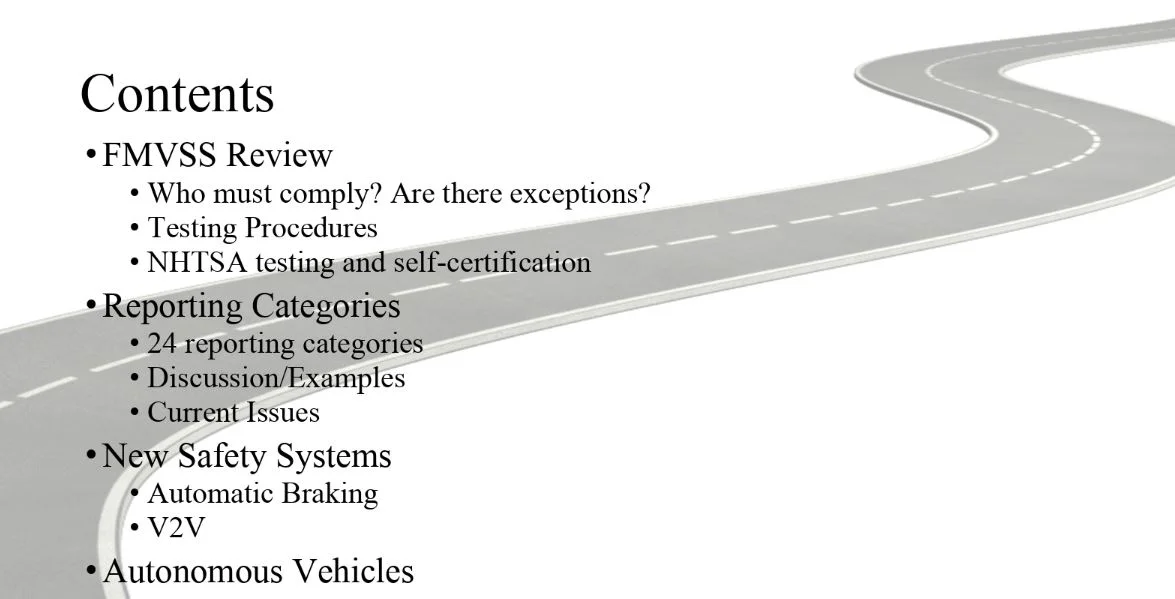This week we look at how we can conduct training or learning sessions on U.S. safety compliance.
OIG Audits NHTSA's Recall Process
The Fixing America’s Surface Transportation Act, or FAST Act for short, required the Office of Inspector General (OIG) to audit the recall processes of NHTSA’s Office of Defects investigation (ODI) and Recall Management Division (RMD). In their most recent report, the OIG found that, despite a 92 percent increase in the number of light passenger vehicle recalls per year and a 199 percent spike in the number of vehicles involved in recalls since 2012, NHTSA has “inadequate controls and processes for verifying and collecting manufacturer - reported information,” which cripples their ability to oversee the implementation of recalls. The OIG’s report identified several key shortcomings in NHTSA’s process and offered recommendations to remedy them.
Primarily the report finds that NHTSA lacks the ability to manage recall remedies, scope, and risk reporting as well as the ability to oversee the implementation of recalls. “The ODI’s monitoring process for light passenger vehicle recall remedies and scope lacks adequate management controls.” The report indicates that the ODI’s process is too limited to ensure that recall remedies are quickly and completely reported by manufacturers. Manufacturers are currently required to report the scope of recalls and recall remedies on an online portal, however, the OIG found that “manufacturers did not submit 28.1 percent of the required scope information in their initial recall reports, and submitted only 4.1 percent of the missing scope information in their final reports.” The RMD does not monitor manufacturers’ compliance with completing scope information which leads to this absence of required data. The report details that the portal used for reporting scope information only identifies some of the regulatory requirements and that there are no “written instructions to show manufacturer's how to meet those requirements.” Furthermore, the OIG found that the RMD does not take steps to verify the completion rates of recall work despite having the authority to do so. Currently manufacturers “obtain completion rate data from their dealerships. The manufacturers’ employees then manually input the data into RMD’s online recall reporting tool. One company official said that this manual process has resulted in reporting errors.” The OIG offered two recommendations to NHTSA to improve manufacturer reporting so that they receive more accurate and complete information. One, that NHTSA “develop, implement, and document management controls, including a supervisory review process, for monitoring recall remedies, scope, and risk reporting and oversight of recall implementation,” and two, that they “update the recall reporting portal and issue written guidance to identify all recall scope, risk, and completion rate information that regulations require manufacturers to submit.
The OIG’s report also indicates that the ODI lacks a way to monitor manufacturer reporting of recall remedies, scopes and risk information. Their processes are “incomplete, as they do not include management controls to ensure compliance with the specific regulatory reporting requirements.” The report also found that the (RMD) does not adequately assess the scope of recalls involving non- compliant or defective equipment. The ODI and RMD also do not have protocol in place to assess the completion of recall communications from manufacturers as the ODI’s process of monitoring “is too narrow to ensure that manufacturers report recall remedies completely and timely.” Finally, the audit found that the staff of the ODI and RMD lack sufficient understanding of what is required of them in terms of recall monitoring and oversight. While RMD policy states that an engineer must review the manufacturers’ technical remedy instructions for high and medium priority recalls, the RMD did not document the engineers’ technical reviews in its official records. Instead, the engineers kept informal records of this work.” This lack of formal documentation lead to NHTSA being unable to verify that the Vehicle Defects Division, Office of Vehicle Safety Compliance, and RMD staff conducted appropriate technical reviews for 1,381 recalls, and that further action was not required. For these issues the OIG issued three recommendations. One, That NHTSA “develop and implement a risk-based process to monitor manufacturers’ reporting of recall remedy, scope, and risk information,” Two, that NHTSA “develop and implement a risk-based process—with specific timelines— that provides guidance for Office of Defects Investigation staff on identifying recalls with missing communications,” and three, that NHTSA “develop a training curriculum on staff responsibilities for updated recall monitoring and oversight processes.”
Overall, the Office of the Inspector General found that NHTSA’s management of light passenger vehicle recalls was lacking in several very important categories. NHTSA’s ODI and RMD do not employ adequate processes to ensure the proper reporting of recall scope and remedies, nor the completion of recalls, while their staff lacks proper training and understanding of their responsibilities. This leads to them having incomplete information and documentation of many large aspects of the recall process, making their overall approach to recall management inadequate. The gaps indicated by the OIG’s report highlight the need for manufacturers’ to be proactive and more self reliant when it comes to safety, and recall processes. This is no easy task given the sometimes confusing regulatory requirements of NHTSA. Kinetic Metrics has years of experience and expertise in NHTSA’s Processes and employs unique methods to assist manufacturers’ with this challenge. To read the full OIG report please go to https://www.oig.dot.gov/library-item/36626.

